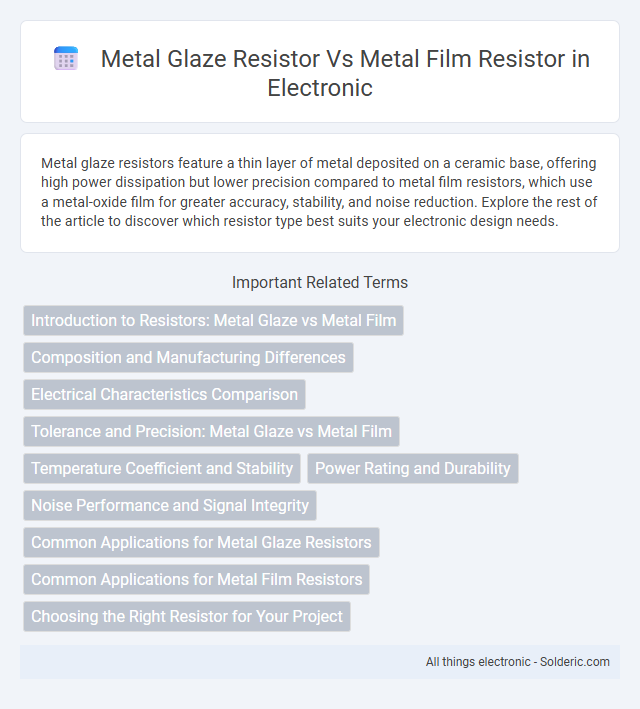Metal glaze resistors feature a thin layer of metal deposited on a ceramic base, offering high power dissipation but lower precision compared to metal film resistors, which use a metal-oxide film for greater accuracy, stability, and noise reduction. Explore the rest of the article to discover which resistor type best suits your electronic design needs.
Comparison Table
| Feature | Metal Glaze Resistor | Metal Film Resistor |
|---|---|---|
| Construction | Resistor film deposited by metal glaze coating | Resistor film created by sputtering metal film on ceramic |
| Tolerance | +-5% to +-10% | +-1% to +-5% |
| Temperature Coefficient | Higher (typically +-200 ppm/degC) | Lower (typically +-50 ppm/degC) |
| Noise | Higher noise levels | Low noise, suitable for audio circuits |
| Power Rating | Usually 0.25W to 1W | Typically 0.25W to 2W |
| Stability & Reliability | Moderate stability and reliability | High stability and long-term reliability |
| Cost | Lower cost | Higher cost |
| Application | General-purpose, low precision applications | Precision circuits, audio, and measurement equipment |
Introduction to Resistors: Metal Glaze vs Metal Film
Metal glaze resistors feature a ceramic base coated with a metal-glass glaze, offering high temperature stability and superior pulse load capability compared to metal film resistors. Metal film resistors, constructed by depositing a thin metal layer on an insulating substrate, provide enhanced precision, low noise, and tight tolerance for accurate circuit applications. Your choice between these resistor types depends on the required stability, noise level, and precision in electronic designs.
Composition and Manufacturing Differences
Metal glaze resistors feature a resistive layer created by glazing a metal oxide film onto a ceramic core, combining high-temperature firing and a glassy coating for durability and stability. Metal film resistors utilize a thin metal alloy film deposited via sputtering or evaporation onto a ceramic substrate, allowing precise control over resistance values and tighter tolerances. The manufacturing process of metal glaze resistors involves high-temperature firing to fuse the glaze, while metal film resistors rely on vacuum deposition techniques and subsequent laser trimming for accuracy.
Electrical Characteristics Comparison
Metal glaze resistors exhibit higher temperature coefficients and noise levels compared to metal film resistors, making metal film resistors preferable for precision applications due to their superior stability and lower noise. Metal film resistors have tighter tolerance ranges, typically +-1% or better, while metal glaze resistors often come with wider tolerances, around +-5%. The metal film resistors also offer better long-term reliability and resistance to moisture, enhancing performance consistency in demanding electronic circuits.
Tolerance and Precision: Metal Glaze vs Metal Film
Metal glaze resistors typically have a tolerance range between +-5% and +-10%, making them less precise for applications requiring strict accuracy. In contrast, metal film resistors offer tighter tolerances, commonly +-1% or better, providing superior precision and stability in sensitive electronic circuits. The enhanced tolerance and low temperature coefficient of metal film resistors make them ideal for precision measurement and high-performance applications.
Temperature Coefficient and Stability
Metal glaze resistors typically have a higher temperature coefficient, around 200 to 500 ppm/degC, resulting in less stable resistance values under temperature variations compared to metal film resistors, which offer a much lower temperature coefficient, typically between 5 to 50 ppm/degC. Metal film resistors provide superior stability and precision due to their tightly controlled manufacturing processes and better temperature performance, making them ideal for applications demanding consistent resistance across a wide temperature range. Your choice between the two should consider the operating environment where temperature fluctuations and long-term stability are critical factors.
Power Rating and Durability
Metal glaze resistors typically offer higher power ratings, making them suitable for applications requiring greater energy dissipation. In contrast, metal film resistors provide superior durability due to their precise construction and resistance to environmental factors such as temperature and moisture. Your choice between the two should consider the power demands and long-term reliability required by your specific circuit design.
Noise Performance and Signal Integrity
Metal film resistors offer significantly lower noise levels compared to metal glaze resistors, making them ideal for high-precision and low-noise applications. The tight tolerance and stable resistance of metal film resistors enhance signal integrity by minimizing distortion and maintaining consistent performance over temperature variations. Metal glaze resistors, while cost-effective, typically exhibit higher noise and less stability, which can degrade signal quality in sensitive electronic circuits.
Common Applications for Metal Glaze Resistors
Metal glaze resistors are commonly used in high-voltage applications and pulse circuits due to their ability to handle high energy and transient spikes reliably. These resistors excel in power electronics, such as in power supplies, amplifiers, and military-grade equipment, where durability and thermal stability are critical. Their composition allows for precise resistance values and long-term stability, making them suitable for use in instrumentation and precision measurement devices where accuracy under stress is essential.
Common Applications for Metal Film Resistors
Metal film resistors are widely used in precision electronic circuits requiring stable resistance values, such as audio equipment, instrumentation, and medical devices. Their low noise and tight tolerance make them ideal for signal processing, measurement, and control systems. Metal glaze resistors, while more robust for power applications, are less suited for high-precision environments compared to metal film types.
Choosing the Right Resistor for Your Project
Metal glaze resistors offer high reliability and excellent stability in high-temperature environments, making them ideal for power circuits and high-voltage applications. Metal film resistors provide superior precision, low noise, and tighter tolerance, perfect for audio, measurement, and signal processing projects requiring accuracy. Choosing the right resistor for your project depends on balancing durability needs against precision requirements to ensure optimal performance and long-term reliability.
Metal glaze resistor vs metal film resistor Infographic

 solderic.com
solderic.com